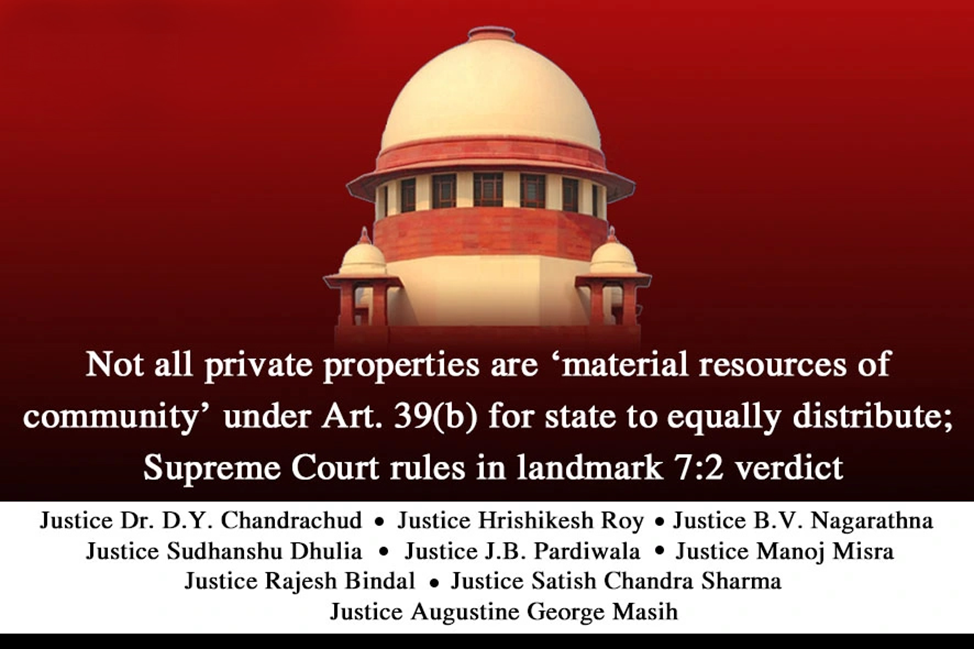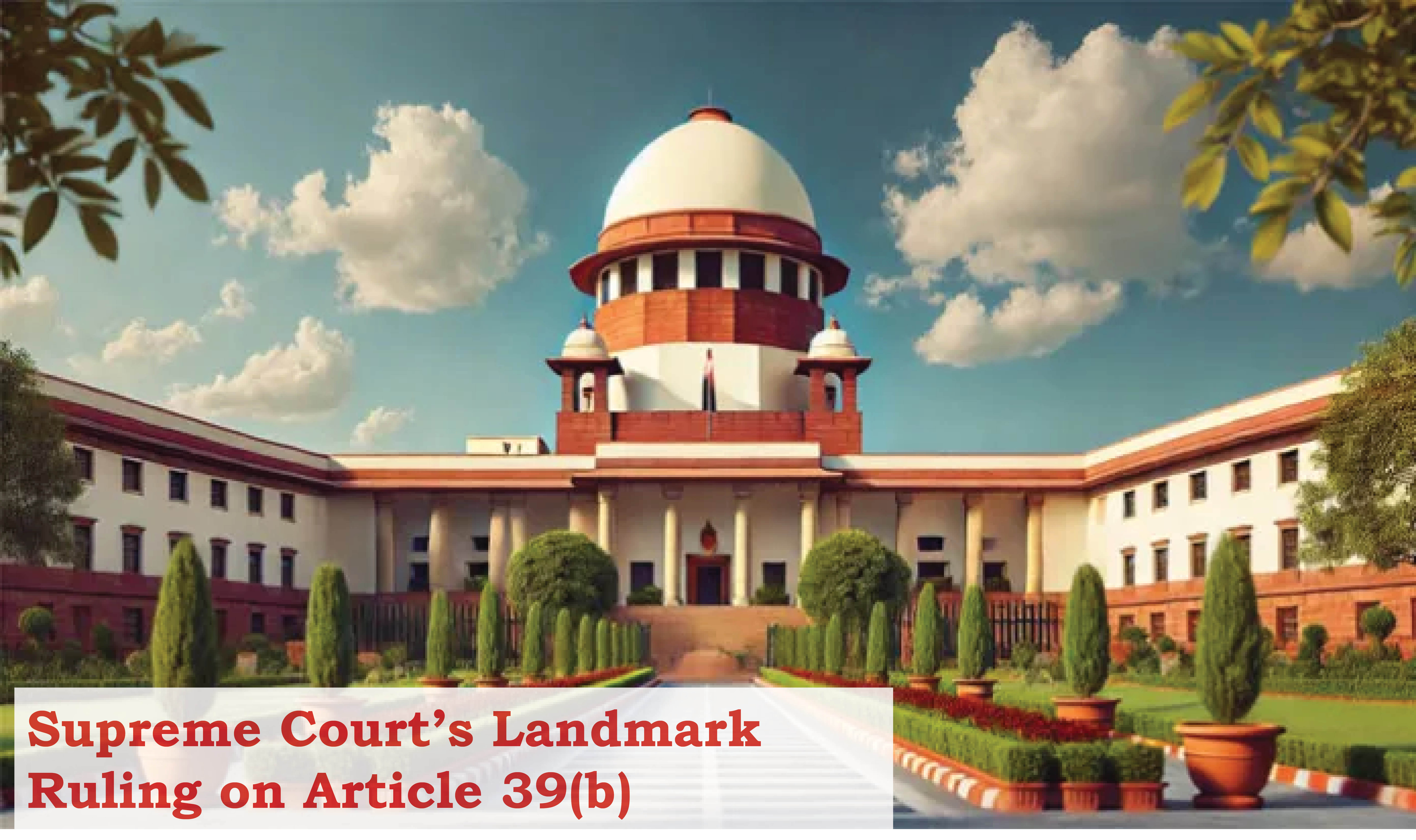Context:
On November 5, 2024, a nine-judge Constitution Bench of the Supreme Court delivered an important verdict, holding that not all private property can be deemed a "material resource of the community" under Article 39(b) of the Indian Constitution for government acquisition and redistribution. The Supreme Court’s judgment deliberated on two key questions related to private property:
1. Validity of Article 31C: The Court examined whether Article 31C, which shields laws promoting equitable resource distribution (as per Article 39(b)), remains valid. This issue arose in light of amendments and prior rulings that narrowed the scope of property rights protections.
2. Interpretation of Article 39(b): The Court also considered whether the government could classify privately owned property as “material resources of the community” under Article 39(b) and thus acquire it for redistribution.
This ruling has far-reaching implications, especially concerning the scope of state intervention in private property and its impact on socio-economic policies.
Understanding Article 39(b)
Article 39(b) is a part of the Directive Principles of State Policy (DPSP), which outlines the broader social and economic goals the state is expected to achieve. Specifically, Article 39(b) directs the State to ensure that the ownership and control of the material resources of the community are distributed in a way that promotes the common good.
- DPSP vs. Fundamental Rights: The conflict between DPSPs and Fundamental Rights (outlined in Part III of the Constitution) has long been a subject of judicial interpretation. While fundamental rights are enforceable by courts, DPSPs are guiding principles that are not legally binding but indicate the direction the state should aim for.
Evolution of the Right to Property
The concept of property rights in India has undergone significant changes since the adoption of the Constitution. Initially, the right to property was considered a fundamental right under Articles 19(1)(f) and 31. However, this right was progressively curtailed through constitutional amendments.
1. The 25th Amendment (1971): The introduction of Article 31C provided immunity to laws aimed at fulfilling the objectives of Articles 39(b) and 39(c), even if they conflicted with fundamental rights. This allowed the government to regulate property rights to promote social justice and equitable resource distribution.
2. Kesavananda Bharati Case (1973): In this case, the Supreme Court upheld the validity of Article 31C but subjected it to judicial review, ensuring that laws infringing upon fundamental rights could still be scrutinized.
3. 1978 Amendment: The right to property was downgraded from a fundamental right to a constitutional right under Article 300A, ensuring that the government could acquire private property for public purposes with fair compensation.

The Supreme Court Judgment on Private Property
In the case of Property Owners’ Association v. State of Maharashtra, the Court clarified the interpretation of Article 39(b) and its implications for government acquisition of private property.
1. Clarification of Article 31C: The Court reaffirmed that the protections offered under Article 31C are still valid, but only in relation to the objectives of Articles 39(b) and 39(c). It ruled that the government's authority to acquire private property is not absolute and must be justified on a case-by-case basis.
2. Narrowing the Scope of Article 39(b): The judgment rejected the broader interpretation of Article 39(b) that allowed the government to acquire all private property as “material resources of the community.” The Court emphasized that only specific resources that meet certain criteria, such as their public trust status, scarcity, and potential harm from monopolization, could be considered for redistribution.
3. Material Resource Consideration Factors:
o Public trust doctrine
o Resource's intrinsic qualities
o Community impact
o Scarcity and monopolization risks
4. Clarification of Distribution: The term “distribute” under Article 39(b) was clarified to mean that the government can either acquire or redistribute resources to private parties, as long as it serves the common good.
Implications of the Supreme Court Ruling
The ruling has several significant implications for the interpretation of property rights and the scope of government intervention:
1. Narrowing the Scope of Government Power: The judgment limits the government’s power to acquire private property. It reinforces the primacy of individual property rights and restricts the automatic government intervention that has been a feature of past policies.
2. Economic Democracy: The Court emphasized that its role is not to prescribe specific economic policies but to support an "economic democracy," as envisioned by the Constitution. This aligns with the principles of private ownership and equitable distribution of resources.
3. Respecting Evolving Market Realities: The judgment recognizes the evolving nature of property, particularly in sectors like data and space exploration, where the concept of "private property" has changed. The Court acknowledges that market realities must be considered when making decisions about resource distribution.
4. Guiding Policies of the DPSPs: The Directive Principles of State Policy (DPSPs), while non-enforceable, remain guiding policies for the state. The Court reinforced that the government's role is to work within these guidelines while respecting the Constitution’s emphasis on fundamental rights.
5. Protection for Marginalized Communities: The ruling ensures that marginalized communities, particularly those dependent on small farms or forest lands, are protected from arbitrary acquisitions. The Court highlights the importance of responsible management of essential public resources.
6. Market-Oriented Economic Model: The decision affirms that India’s economic model is now market-oriented, and the government’s role in resource distribution should align with this model, focusing on both private property rights and community welfare.
Conclusion
The Supreme Court's ruling on private property and Article 39(b) underscores a balanced approach to property rights, where both private ownership and community welfare are protected. The judgment limits the government's power to acquire private property while recognizing the need for redistribution of certain resources for the public good. It reaffirms the role of the judiciary in ensuring that government actions respect constitutional guarantees, providing clarity on the evolving relationship between the state, private property, and socio-economic policies in India. This ruling will guide future legal interpretations and policies regarding property acquisition and redistribution, aligning them with both the Constitution’s vision of social justice and the realities of a market-oriented economy.
|
Probable questions for UPSC Mains exam: Examine the significance of Article 39(b) of the Indian Constitution in the context of the recent Supreme Court ruling on private property. What implications does this ruling have on the state's role in property acquisition? |







